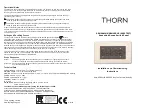
177
MSTP configuration
As a Layer 2 management protocol, the Spanning Tree Protocol (STP) eliminates Layer 2 loops by selectively
blocking redundant links in a network, and also allows for link redundancy.
Recent versions of STP include Rapid Spanning Tree Protocol (RSTP) and Multiple Spanning Tree Protocol
(MSTP). This chapter describes the characteristics of STP, RSTP, MSTP, and the relationship among them.
STP
STP was developed based on the 802.1d standard of IEEE to eliminate loops at the data link layer in a local
area network (LAN). Networks often have redundant links as backups in case of failures, but loops are a
very serious problem. Devices running STP detect loops in the network by exchanging information with one
another, and eliminate loops by selectively blocking certain ports to prune the loop structure into a loop-free
tree structure. This avoids proliferation and infinite cycling of packets that would occur in a loop network
and prevents decreased device performance caused by receiving duplicate packets.
In the narrow sense, STP refers to the IEEE 802.1d STP. In the broad sense, STP refers to the IEEE 802.1d
STP and various enhanced spanning tree protocols derived from that protocol.
STP protocol packets
STP uses bridge protocol data units (BPDUs), also known as configuration messages, as its protocol packets.
STP-enabled network devices exchange BPDUs to establish a spanning tree. BPDUs contain sufficient
information for the network devices to complete spanning tree calculation.
STP uses the following types of BPDUs:
Configuration BPDUs, used for calculating a spanning tree and maintaining the spanning tree
topology.
Topology change notification (TCN) BPDUs, which notify network devices of network topology
changes.
Basic concepts in STP
Root bridge
A tree network must have a root bridge.
There is only one root bridge in the entire network. The root bridge is not permanent, but can change with
changes of the network topology.
Upon initialization of a network, each device generates and periodically sends out configuration BPDUs
with itself as the root bridge. After network convergence, only the root bridge generates and periodically
sends out configuration BPDUs. The other devices only forward the BPDUs.
Root port
On a non-root bridge, the port nearest to the root bridge is the root port. The root port communicates with
the root bridge. Each non-root bridge has only one root port. The root bridge has no root port.
Содержание V1910
Страница 1: ...1 HP V1910 Switch Series User Guide 5998 2238 Part number 5998 2238 Document version 2 ...
Страница 85: ...73 c Display the rate settings of ports ...
Страница 102: ...90 a Port traffic statistics ...
Страница 186: ...174 a The MAC tab Click Add in the bottom to enter the page as shown in b b Create a MAC address entry ...
Страница 252: ...240 b The Port Setup tab ...
Страница 260: ...248 d The Port Setup tab ...
Страница 362: ...350 a Ping operation summary ...
Страница 421: ...409 c Configure authorized IP ...
Страница 479: ...467 Index A B C D E F G H I L M O P Q R S T V W ...
















































